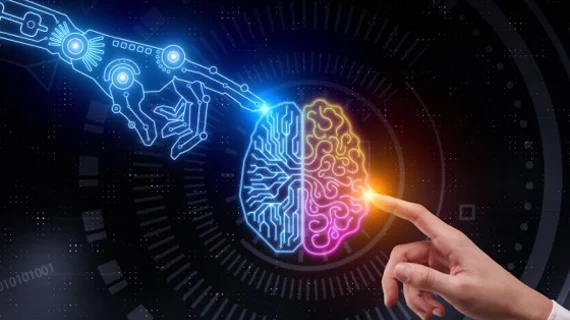Hello AI, Goodbye Radiology as We Know It
What Will Radiologists Do When They’re the Augmenters?
How long will it be before artificial intelligence replaces the first radiologist? A paper published Jan. 1 in Nature suggests this day will come sooner than many of us thought.
The article, “International evaluation of an AI system for breast cancer screening,” authored by Google machine learning engineer Scott Mayer McKinney and colleagues, describes an AI system able to interpret screening mammograms more accurately than radiologists. (It’s probably no accident that this article was published online on the first day of a new decade.)
Until now, AI has outperformed radiologists only in limited aspects of a larger imaging study—counting and measuring lung nodules on CT, for example, or detecting pneumothoraxes on chest X-rays. But the system described in Nature is a major advancement: It’s the first system able to interpret an entire type of study better than radiologists.
The appearance of this system marks the beginning of the end of the practice of diagnostic radiology.
Intelligent Enough
A machine able to interpret diagnostic imaging studies better than radiologists has long been foreseen, yet its arrival comes almost as a surprise. We have underestimated the potential of AI to perform the kinds of work we do. We continue to overestimate the amount of control we as radiologists will have over either the development of AI or the application of that technology to radiology.
We’ve underestimated the potential of AI for perfectly good reasons. Our experience with the AI of 20 years ago—awkward, error-filled systems that often made radiologists’ work harder rather than easier and didn’t improve the quality of reports—was discouraging. And the term artificial made it easy to believe that the intelligence produced by machines always would be a somehow false and inferior kind of intelligence.
This was a mistaken assumption. Just as in physics power is a measure of the ability to perform work, so intelligence, in cognitive science, is a measure of the ability to solve problems.
Machines can be built to produce both. We are not talking here about machines becoming human. We’re talking about machines with the intelligence to solve the kinds of imaging puzzles radiologists face every day.
Qualified for Our Jobs?
The first commercial steam engine in 1698 sat on a platform and slowly pumped water out of a mine. Who at that time could have imagined that the descendants of that immobile machine would haul freight cross-country or fly from New York to London?
Similarly, anyone who had to deal with early mammographic CAD might find it hard to believe that computers would eventually perform the varied and complex work of diagnostic imaging—analyzing images, comparing studies across modalities and time, correlating patient records and lab values, and producing clear and definitive reports.
Yet these are all tasks at which computers are beginning to excel. Cognitive and computer scientists are in broad agreement on the forecast that, as machines became stronger than we are, machines will become more intelligent than we are.
Radiologists are not controlling the development of artificial intelligence. Most of this work is being done by government and business. We can modify these AI systems to help us in specific tasks, but we are generally not creating the underlying hardware and software any more than farmers 100 years ago built the tractors that replaced their horses and oxen.
And we will not ultimately control the use of AI in our own profession. The use of artificial intelligence in radiology will be controlled by governments, insurance companies and imaging providers who will push for ever-greater accuracy and efficiency and ever-lower costs.
Picking on Radiology
AI does not need to be perfect in order to replace a radiologist. It simply needs to be better than a radiologist. If using AI allows radiologists to produce more accurate reports, then radiologists will be required to use AI. If AI by itself reads a study better than do AI and a radiologist working together—and this can happen even now, with the input of a radiologist dragging down the performance of the AI—then AI will be required to read that study alone.
Diagnostic imaging studies have been increasing in number, complexity and amount of information. During the next few years AI will be a great help to radiologists in handling that difficult and sometimes overwhelming amount of work. At some point, however, the increasing use of AI will begin to reduce the number of studies that will require a radiologist to interpret them.
All this raises difficult and contentious questions which so far do not have clear answers:
▲ What will this replacement process look like?
▲ How should radiologists now in practice begin to prepare for this change?
▲ How many radiologists are likely to be needed in five, 10 or 20 years?
▲ How many radiology residents will be needed and what kind of training should they be given?
No other medical profession has yet faced this kind of challenge. The radiology community is trying to find a path forward without a map.
Uncertain Identity
If we overestimate the speed at which AI will advance, and radiologists leave for other specialties and too many radiology residency positions go unfilled, we may end up with a shortage of radiologists. If we downplay the speed and impact of AI too much, we may end up training radiologists who will not be able to find work.
The widespread use of artificial intelligence will be good for medicine. Patient care will be better, faster, less expensive and more equitable. This is our goal as physicians. But AI will not end up being good for the specialty of radiology.
So, when will AI replace the first radiologist?
If that experimental system described in Nature were currently being used in clinical practice, the answer would be “now.” AI will not replace every radiologist, nor will computers learn to read every type of imaging study all at once. But as computers begin to handle an ever-larger number of studies, radiologists will spend less time working in front of monitors and more time dealing directly with patients. As physicians, we can certainly do this.
What is not at all clear is whether we will still be called radiologists.
Dr. Schier is a radiologist with multistate, Los Angeles-based RadNet. The views expressed here are his own.

